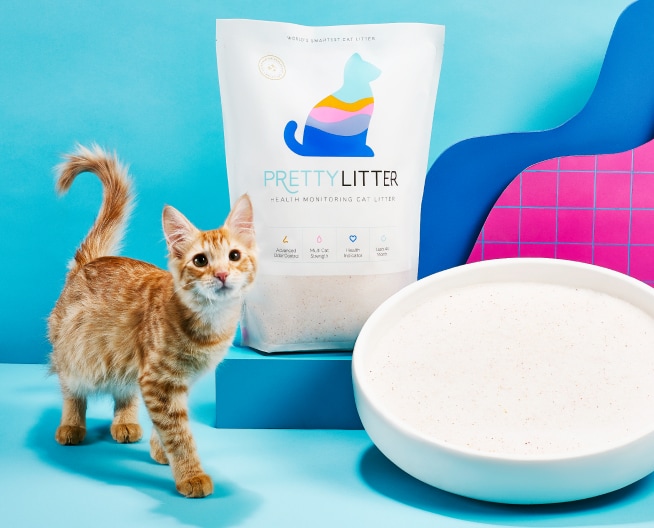February 15, 2022 |11 min read
Senior Cat is Losing Hair: 6 Reasons Why

Written by

As a cat person, you’re no doubt used to finding cat hair everywhere. Black pants are a strict no-no, and the couches need a weekly vacuum. A cat losing fur is more common than you think, but just keep in mind that shedding is one thing; excessive hair loss is another.
Unless you have a hairless Sphynx cat, full or partial cat hair loss (also called feline alopecia) is a sign that something is not quite right. Thankfully, most times that “something” is easy to resolve.
But safe is always better than sorry, and on the off chance that your cat’s case of feline alopecia points to a rare condition, you’ll want to get to the bottom of it as soon as possible. If you’re wondering why your furry friend is looking less furry lately, keep reading for six potential reasons and what you can do to improve your cat's health.
#1 Natural Causes
Sometimes, a cat losing hair fur is perfectly natural—especially as they age. Like humans, senior cats can experience thinning fur or mild hair loss unrelated to concerns regarding their general health.
Hereditary hair loss also exists among felines, though it’s more common with younger animals, sometimes occurring at birth or not long after.
Finally, keep in mind that shedding of dead hair is normal for cats of all ages. Even if you’re finding more cat fur around the house than usual, you don’t necessarily need to be concerned. As long as you don’t notice bald spots on your furry friend, it’s more likely that their hair loss is part of the natural hair replacement cycle.
What You Can Do
Aging is a natural part of life. Apart from understanding your cat’s age in human years and keeping their quality of life high, there’s not much action to take against the onward march of time.
However, even if you suspect your cat’s hair loss may be natural, it’s worth taking steps to rule out other possible cat health problems.
#2 Over-Grooming
Technically, cat over-grooming is self-inflicted hair removal rather than hair loss. Still, when old Mr. Whiskers shows up for dinner with bald patches, it doesn’t matter if he did it to himself or not. Missing hair is missing hair, and an investigation is in order.
There are three reasons a cat might groom themself excessively:
- Itchiness – When cats have itchy skin, they tend to pull at their fur. Allergic reactions to the cat food or flea bites, lice, ear mites, scabies, and ticks can all lead to uncontrolled scratching. Therefore, it is important to stay attentive to your pet’s health and allergic reactions.
- Pain – From arthritis to broken bones, pain or discomfort can cause excessive licking on the same bald spot and loss of hair. And because joint pain and other conditions are more common in older cats, they’re more likely to have an ache that leads to biting or scratching. This could also be the cause of an elderly cat yowling or not eating.
- Anxiety – A stressed or anxious cat may lick themselves as a way to self-soothe. Why? Grooming releases endorphins, so cats will give themselves a bath to relax.
Of course, some cat grooming is normal. But if you notice that Mr. Whiskers won’t stop licking at the same spot, there may be an underlying cause or issue.
On the other hand, you may not see your cat clean themselves at all. Kitties will often find somewhere out of sight to lick and pull at a skin irritation. This tendency to hide can make it more challenging to recognize that your fur baby is over-grooming.
If your cat prefers to clean themself in private, you’ll need to look for the more obvious signs of excessive grooming. Watch for short patches of fur or bald spots, more frequent hairballs, and red sores beneath the cat's coat.
What You Can Do
To stop your cat from over-grooming, you’ll first have to determine the cause.
First, thoroughly check your cat’s skin for signs of fleas, ticks, lice, or any other critter that might be causing discomfort. Allergy to specific cat food is also important to be aware of in considering the factors of your cat's hair loss. You’ll also want to feel for swelling or broken bones. If your cat won’t let you near a particular spot, there’s a high chance that spot is giving them trouble.
When a once-over doesn’t turn up any clues, you might have an anxious feline on your hands. To calm your cat, work to create a comfortable environment free of loud sounds and other pets. Changes in routine or frequent travel can also lead to stress in cats, so try to maintain a sense of regularity.
In some cases, antidepressants or antianxiety medication may be necessary. Most of the time, however, extra care and some environmental changes will do the trick.
#3 Side Effects from Other Treatments
Cats don’t understand that long list of side effects at the end of drug commercials, so they won’t know if their medication is causing hair loss. However, as a cat owner, you can carefully review the medication’s information to draw a possible link.
Some medicines can lead to minor or significant pet hair loss. For example, if your cat has to take corticosteroids for an extended period (perhaps to reduce inflammation and treat a preexisting skin problem), they may experience hair loss or thinning as a side effect.
What You Can Do
If you believe that a medication is causing feline alopecia, call the vet who prescribed it and ask them, “Why is my cat losing hair?” Discontinuing use without consulting a professional could worsen whatever condition the medication is supposed to help.
Overall, hair loss is a relatively mild side effect of medication. In many cases, it will subside once treatment is complete, and hair regrowth is likely.
#4 Infected Areas
While out and about, cats may pick up any number of infectious diseases. While that sounds alarming, keep in mind that most infections are mild and easily curable. However, some diseases may destroy the hair follicle and prevent further growth. Afflictions that cause hair loss include:
- Ringworm
- Staph infection
- Mange
- Other fungal infections
A telltale sign of infection-related hair loss is localized baldness. If you spot a scaly bald patch or a ring of missing hair, it’s time for a trip to the vet to address the possible skin condition and address disease-related hair loss.
What You Can Do
To avoid cat infections, keep your home and your cat clean, and wash your hands often.
When skin infection strikes, topical treatments are the most common solution, though you may also need to give your cat oral antifungal drugs or medicated baths. Your vet will be able to prescribe the best combination of treatments to clear up the infection. Learn more about cat skin disorders.
Post-infection, do your best to minimize skin irritation and wash all toys and beds to prevent reinfection. You may need to discard items that you can’t disinfect (such as scratching posts and cat trees).
#5 Hormonal Imbalances
Sometimes, hair loss is caused by internal factors like hormonal changes. One of the more common diseases in older cats is hyperthyroidism, whereby an enlarged thyroid gland produces excess T3 and T4 hormones. Apart from hair loss, hyperthyroidism can lead to:
- Weight loss
- Vomiting
- Diarrhea
- Increased appetite and thirst
- Frequent urination
- Hyperactivity
Higher or lower levels of other hormones can also cause hair loss or keep hair from regrowing. However, not all hormone imbalances lead to losing hair, so you can’t treat hair loss as a sole indicator of internal issues.
What You Can Do
Should you notice excessive hair loss, unusual cat behavior, or other symptoms like the ones listed above, bring your cat in for a veterinary assessment to determine the underlying cause. Thankfully, most hormonal disorders are treatable through medication. In rarer cases, surgery or radiotherapy may be necessary.
Regardless of the necessary therapy, hyperthyroidism and most other endocrine disorders are treatable, though they might require lifelong attention.
Using a color-changing litter like PrettyLitter can help you pinpoint the cause of your cat’s fur loss early by notifying you of potential health issues (or confirming that nothing is seriously wrong). Of course, for an official diagnosis, be sure to visit your local animal hospital or veterinary clinic.
#6 Cancer
Most of the time, cat cancer does not cause fur loss. Without a range of other symptoms, you can be fairly certain that your balding buddy doesn’t have cancer. Cancer symptoms in cats include:
- Abnormal discharge or bleeding
- Growing lumps
- Persistent coughing
- Lethargy
- Difficulty urinating or defecating
- Odor or bad breath
- Sores that don’t heal
Again, without the presence of additional symptoms like these, you can likely rule out cancer altogether. With that said, some rare forms of cancer—such as neoplasia—can lead to feline hair loss.
What You Can Do
Before you have a conclusive diagnosis from a vet, don’t freak yourself out. A bald patch won't necessarily confirm a cancer diagnosis. And even once you receive confirmation, know that cat cancer is far from untreatable. With the technology available today—including chemotherapy, radiation, and surgery—many older cats with cancer are able to live long, comfortable lives.

Is Your Cat Missing Hair? Don’t Despair!
If you see your older cat losing hair, don’t start pulling yours out. Chances are that it’s a sign of something relatively minor like a food allergy or flea bites. And if it is a symptom of a rarer illness, fear not—feline hair loss is often an advance warning, and noticing it early is the first step in starting treatment for an underlying issue.
At PrettyLitter, we believe that the best defense against feline sickness is a solid offense, and that means frequently checking on your cat’s well-being. You might sum up our philosophy in six words: preventative medicine is the cat’s pajamas.
Our silica litter helps you stay on top of your cat’s health by monitoring the acidity and alkalinity of their urine. The color-changing formula helps you to know what’s going on with your cat’s general health at all times—even before you start finding hair around the house.









